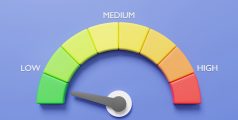
Understanding Debt-to-Income Ratio
Posted on Thursday, October 24th, 2024 | By IndusInd Bank
Whether you’re seeking a personal loan, a home loan, or any other borrowing options, one of the most crucial factors lenders evaluate is your Debt-to-Income (DTI) ratio. This simple yet powerful percentage helps lenders assess your repayment capacity and guides you in managing your overall debt.
A clear understanding of your DTI ratio is vital before applying for a personal loan, as it directly impacts your chances of approval. A high DTI ratio could limit your loan options or result in less favourable terms, while a healthy ratio might unlock better opportunities
What Is the Debt-to-Income (DTI) Ratio?
Your Debt-to-Income Ratio, or DTI, compares your monthly debt payments to your gross monthly income. It tells you what percentage of your earnings goes toward repaying debts like loans, credit cards, and EMIs. A lower DTI generally signals healthy financial standing, while a higher DTI may raise red flags for lenders.
Why Is DTI Ratio Important?
Lenders use your DTI ratio to determine how easily you can take on and repay a new loan. It’s a direct reflection of your financial commitments. A low DTI suggests that your income is well-balanced against your debts, making you a safer borrower. On the other hand, a high DTI might indicate over-leverage, which can make loan approval more difficult.
How to Calculate Debt-to-Income Ratio?
Calculating your debt-to-income ratio is straightforward. Here’s how you can do it:
Add Your Monthly Debt Payments
Include all recurring debts, like home loans, car loans, credit card payments, and existing personal loans.
Calculate Your Gross Monthly Income
This includes your total income before taxes, including salary, bonuses, and other incomes.
Divide Your Debt Payments by Your Income
Divide the total monthly debt payments by your gross monthly income.
Multiply by 100 to Get a Percentage
Now, multiply the result by 100 to express the DTI ratio as a percentage.
For example, if your total monthly debt payments are ₹40,000 and your gross monthly income is ₹1,00,000, your DTI ratio would be 40%.
Also Read: What is the MCLR Rate and How Does it Affect Loans?
Debt-to-Income Calculation Formula
Here’s the standard formula:
DTI Ratio (%) = (Total Monthly Debt Payments / Gross Monthly Income) × 100
Example:
If your total monthly debt is ₹25,000 and your monthly income is ₹75,000:
DTI = (25,000 / 75,000) × 100 = 33.33%
This calculation provides valuable insight into your financial situation. It helps you understand how much of your income is committed to debt.
Ideal DTI Ratio: What Lenders Prefer?
In India, most lenders consider a DTI ratio of 30-40% acceptable. A ratio within this range means you can manage extra debt without financial strain. But, a ratio above 50% may raise red flags, which makes it harder to secure favourable loan terms.
For instance, when applying for a personal loan, lenders will scrutinise your DTI ratio. This is to gauge your repayment capacity. A lower DTI can improve your chances of loan approval. It might even help you secure a lower interest rate, as it reflects better financial stability.
Managing and Improving Your DTI Ratio
If your DTI ratio is high, here are some strategies to improve it:
- Focus on reducing existing debt, particularly high-interest loans. This will lower your monthly debt payments and improve your DTI ratio.
- Explore additional work or other income sources to boost your gross monthly income.
- Until your DTI ratio is at a comfortable level, avoid taking on new debt.
DTI Ratio and Personal Loans: What You Need to Know
When applying for a personal loan, your DTI ratio is a significant factor in the lender’s decision-making process. A lower DTI ratio means a higher capacity to manage additional debt, which makes you a more attractive borrower.
Understanding your DTI ratio is key to maintaining financial health. It is also important to make sound borrowing decisions. A healthy DTI ratio improves your loan eligibility and ensures you can comfortably manage your financial obligations.
FAQs Related to Debt to Income Ratio
- What is a good Debt-to-Income Ratio?
A DTI of 20% to 35% is considered good. Below 20% is excellent and increases your chances of loan approval.
- How often should Debt-to-Income Ratio be calculated?
It’s wise to review your DTI at least once every quarter, or before applying for a major loan. - What does a high Debt-to-Income Ratio indicate?
It suggests you may be overburdened with debt and might struggle with additional repayments. This could lead to loan rejections or higher interest rates. - What does a low Debt-to-Income Ratio indicate?
It means your income sufficiently covers your debt, making you a low-risk borrower in the eyes of lenders.



 Offers
Offers Rates
Rates Debit Card Related
Debit Card Related Credit Card Related
Credit Card Related Manage Mandate(s)
Manage Mandate(s) Get Mini Statement
Get Mini Statement
 categories
categories Bloggers
Bloggers Blog collection
Blog collection Press Release
Press Release


